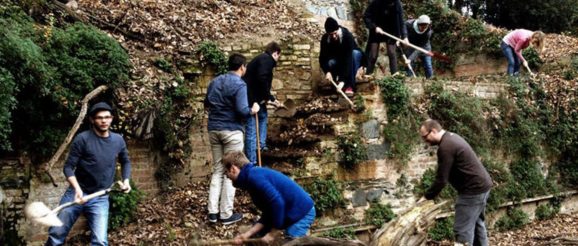From mutations…
Against a background characterised by major ecological, social and economical changes (climate change, fordist productive apparati decline, digital revolution, ecological awareness, rise of knowledge based and collaborative economy…), cities appear to be the core of transitions. Thus, urban planning processes are steadily replaced by a tactical, ephemeral and collaborative urbanism. The starchitects and engineers seem to be fading in favor of collectives, “makers” and shared gardens. Inhabitants and users turn into “citizen contributors”, the “soft” takes revenge on the “hard”. Gradually, the public/private legal framework is replaced by common interest.
A new pattern of urban innovation is emerging: the model of “urban labs”. It defends a new right to the city, through the affirmation of a right to co-produce and experiment full size the city. Thus inhabitants, tourists, entrepreneurs, “users” are encouraged to act on the making of the city, to participate, test, evaluate and coproduce the innovations, services and urban data. Experiences are many now and spread outward throughout the cities: Barcelona (Fab City, Valldaura Self Sufficient Labs, Ateneos de fabricación digital), Madrid (Media Lab Prado, Laboratorios ciudadanos, Mares), Paris (Paris Région Lab, Fab City Grand Paris), Nantes (Nantes City Lab), Helsinki (Forum Virium Helsinki), Johannesbourg (Maboneng District), Medellín (Medellín Lab), Mexico (Laboratorio para la ciudad) and Rosario, in Argentina (Laboratorio de Innovación Ciudadana).
These urban labs differ from the major models of planification of creative cities and smart cities. They preserve a collaborative conception of urban innovation, where it is less question of planning districts dedicated to creativity, than innovating in the field of urban policies capable of accompanying ascendant dynamics: digital collaborative tools, methods of coproduction and urban design, call for proposals published on digital platforms, policies of temporary use of vacant spaces, etc. Users and actors of collaborative economy are given by urban labs the role of producers of innovations and of the fabric of the cities. They do not surrender to the technological determinism of Smart Cities, which found serious positive ecologic and socioeconomic effects to the technics. Their strategy is to hijack technologies and socially embed them, in order to make them tools made to serve the city and the citizens.
… to tensions
Urban labs induce many transformations in the way we make the city. Rather than focusing on the analysis of mutations, it is accordingly essential to question the existing tensions within urban labs. These spaces act as frictional areas, territories for experimentation and invention of new lifestyles, new urban, organisational and structural methods. Therefore, they are unstable and prone to every kind of tension:
-
Polis vs the city. The first friction arises between the willingness to “make the city”, to act locally, to “urbanise” technologies, and a temptation to develop generic models of City Labs or Living Labs, regardless of the cities specificities.
-
Institution vs agility. Another tension appears between the intention to stimulate the ascendant processes by agile methods in interstitial, peripheral and non-institutional spaces, and the tendency to plan innovation processes in specific places.
-
Town planning code vs source code. Another resistance results from a willingness to experiment real scale and act on the source code of the city production, and a temptation to normalise and regulate these innovation processes, in the framework of rigid evaluation protocols, including a battery of criteria and indicators.
-
Voter’s card vs payment card. A fourth tension regards the status of the inhabitants and users of these urban labs. Are they considered as mere “beta testers” of the innovations or as full contributors, with a real expertise autonomy and ability to act on the evolution of experimentations.
-
Knowledge vs science. A fifth resistance is about a former dichotomy between science and knowledge, between scientific disciplines and practical skills, between pure science and action knowledge. Speaking of experimentation and laboratory, we are also talking about science, with hypothesis, field investigations and research protocols, which methodological rigor may vary considerably depending on research programs and projects.
-
Knowledge society vs knowledge economy. The sixth tension results of the willingness to think and act on urban commons, by creating neither private nor public shared spaces for instance, and an opportunity to capture and enhance externalities, knowledge and free cognitive resources, developed on the free and open-source model.
-
Social innovation vs technical innovation. Another friction appears between the technical and diffusionist approaches of innovation, and a more social and interactionist approach, which is only conceivable in the interaction between technological, social and urban cultures.
-
Underground vs Upperground. The last tension arises between the “upperground” logic of the actors and the more formal innovation sectors (firms, research laboratories, universities, technological and digital sectors…) and “underground”, informal actors of innovation (citizens, users, cultural and artistic actors).
Regulating tensions and transforming urban public action
Through the reading of these tensions, we come to realise the necessity to create a public urban action capable of regulating themselves. The implementation of urban labs must move beyond traditional dichotomies, by opening new spaces to explore urban transitions. But these spaces must neither be local, nor global, neither specific nor generic, neither ascendant nor descendent, neither experimental nor regulated, neither alternative nor institutional, neither scientific nor empirical, neither opened nor closed. Therefore, this is a major stake, which can only be addressed by implementing a new urban policy, less interventionist but more facilitative. An urban policy that will proceed using the trial and error method, and rely on third actors and third places to regulate the tensions and overtake all a priori contradictory oppositions.


